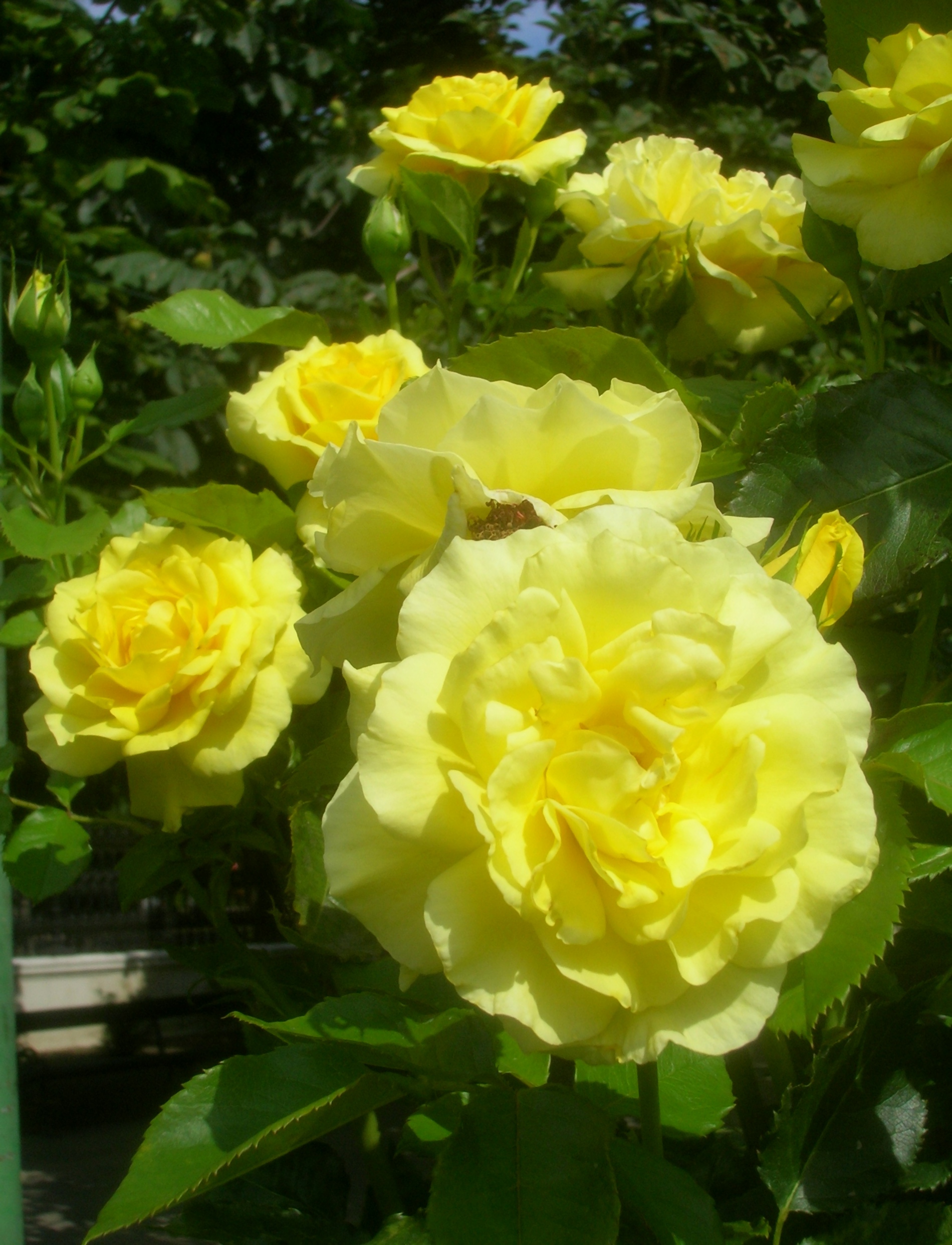|
Heidi Klum Rose
The Heidi Klum rose is a variety of Floribunda rose from the Tantau company, registered in 1999 with the registration number ''RT 00681''. It was made by crossing ''Old Port'' and ''Barkarole'' roses. The variety was officially named by Heidi Klum (after herself) in 2005. It is a compact, richly flowering rose with a powerful scent. Under normal conditions it reaches a height of 40 to 50 cm. The flowers can reach a size of up to 9 cm, and can have as many as 40 petals. The flower color is predominantly violet and the foliage is green and rich. The Heidi Klum rose can tolerate temperatures as low as –23 °C but is somewhat susceptible to mildew and ''Diplocarpon rosae''. Therefore, it needs regular maintenance. Other names Rose 'Heidi Klum', Floribunda rose 'Heidi Klum', Cluster flower rose 'Heidi Klum', Rosa 'Heide Klum Rose', Rosa 'TAN00681', Rosa 'RT00-681'. References variety description at helpmefind (de) Rosa 'Heidi Klum' (Rose 'Heidi Klum') – Shoot ... [...More Info...] [...Related Items...] OR: [Wikipedia] [Google] [Baidu] |
Rosen Tantau
Rosen Tantau (also ''RosenWelt Tantau'') is a rose breeding company located at Uetersen, in the District of Pinneberg in Schleswig-Holstein, Germany. It is one of the most important Rose farms worldwide, and has developed a large number of well-known rose cultivars. Founded in 1906 by Mathias Tantau (1882–1953), it became important in the 1930s. In 1948, his son Mathias Tantau jun. (1912–2006) took over. He developed some famous hybrid tea roses, e.g. 'Polarstern', 'Super Star' or 'Fragrant Cloud', earning many rose awards - 'Fragrant Cloud' was awarded the title ''World's Favorite Rose' in 1981. 1985 Mathias Tantau sold the family business to Hans-Jürgen Evers (1940–2007), who had joined Tantau in 1963. From 2000 to 2007 his son Christian Evers was co-manager of the company he is leading today. The company has about 90 employees and 50 sales agencies around the world. Annually more than two million rose plants are sold worldwide at retail and wholesale, and as many by ... [...More Info...] [...Related Items...] OR: [Wikipedia] [Google] [Baidu] |
Germany
Germany,, officially the Federal Republic of Germany, is a country in Central Europe. It is the second most populous country in Europe after Russia, and the most populous member state of the European Union. Germany is situated between the Baltic and North seas to the north, and the Alps to the south; it covers an area of , with a population of almost 84 million within its 16 constituent states. Germany borders Denmark to the north, Poland and the Czech Republic to the east, Austria and Switzerland to the south, and France, Luxembourg, Belgium, and the Netherlands to the west. The nation's capital and most populous city is Berlin and its financial centre is Frankfurt; the largest urban area is the Ruhr. Various Germanic tribes have inhabited the northern parts of modern Germany since classical antiquity. A region named Germania was documented before AD 100. In 962, the Kingdom of Germany formed the bulk of the Holy Roman Empire. During the 16th ce ... [...More Info...] [...Related Items...] OR: [Wikipedia] [Google] [Baidu] |
Floribunda (rose)
Floribunda (Latin for "many-flowering") is a modern group of garden roses that was developed by crossing hybrid teas with polyantha roses, the latter being derived from crosses between '' Rosa chinensis'' and '' Rosa multiflora'' (sometimes called ''R. polyantha'').Phillips, R. and Rix, M., ''The Ultimate Guide to Roses'', Macmillan, 2004, p226 The idea was to create roses that bloomed with the polyantha profusion, but with hybrid tea floral beauty and colour range. The first polyantha/hybrid tea cross, 'Rødhætte' ('Red Riding Hood'), was introduced by the Danish breeder Dines Poulsen in 1907. It possessed characteristics of both its parent classes, and was initially called a Hybrid Polyantha or Poulsen rose. Poulsen continued this line of work in subsequent years, introducing several Hybrid Polyanthas such as 'Else Poulsen' in 1924. Other breeders also began introducing similar varieties, and in 1930 the name "floribunda" was coined by Dr. J.N. Nicolas, a rose hybridizer ... [...More Info...] [...Related Items...] OR: [Wikipedia] [Google] [Baidu] |
Heidi Klum
Heidi Klum (; born 1 June 1973) is a German-American model, television host, producer, and businesswoman. She appeared on the cover of the ''Sports Illustrated Swimsuit Issue'' in 1998 and was the first German model to become a Victoria's Secret Angel. Following a successful modeling career, Klum became the host and a judge of ''Germany's Next Topmodel'' and the reality show ''Project Runway'', which earned her an Emmy nomination in 2008 and a win in 2013 for Outstanding Host for a Reality or Reality-Competition Program (shared with co-host Tim Gunn). Klum has been nominated for six Emmy Awards. She has worked as a spokesmodel for Dannon and H&M and has appeared in numerous commercials for McDonald's, Volkswagen and others. In 2009, Klum became Barbie's official ambassador on Barbie's 50th anniversary. As an occasional actress, she had supporting roles in movies including '' Blow Dry'' (2001), ''Ella Enchanted'' (2004), and made cameo appearances in '' The Devil Wears Prada' ... [...More Info...] [...Related Items...] OR: [Wikipedia] [Google] [Baidu] |
Petal
Petals are modified Leaf, leaves that surround the reproductive parts of flowers. They are often advertising coloration, brightly colored or unusually shaped to attract pollinators. All of the petals of a flower are collectively known as the ''corolla''. Petals are usually accompanied by another set of modified leaves called sepals, that collectively form the ''calyx'' and lie just beneath the corolla. The calyx and the corolla together make up the perianth, the non-reproductive portion of a flower. When the petals and sepals of a flower are difficult to distinguish, they are collectively called tepals. Examples of plants in which the term ''tepal'' is appropriate include Genus, genera such as ''Aloe'' and ''Tulipa''. Conversely, genera such as ''Rose, Rosa'' and ''Phaseolus'' have well-distinguished sepals and petals. When the undifferentiated tepals resemble petals, they are referred to as "petaloid", as in petaloid monocots, orders of monocots with brightly colored tepals. Sinc ... [...More Info...] [...Related Items...] OR: [Wikipedia] [Google] [Baidu] |
Violet (color)
Violet is the color of light at the short wavelength end of the visible spectrum, between blue and invisible ultraviolet. It is one of the seven colors that Isaac Newton labeled when dividing the spectrum of visible light in 1672. Violet light has a wavelength between approximately 380 and 435 nanometers. The color's name is derived from the violet flower. In the RGB color model used in computer and television screens, violet is produced by mixing red and blue light, with more blue than red. In the RYB color model historically used by painters, violet is created with a combination of red and blue pigments and is located between blue and purple on the color wheel. In the CMYK color model used in printing, violet is created with a combination of magenta and cyan pigments, with more magenta than cyan. Violet is closely associated with purple. In optics, violet is a spectral color (referring to the color of different single wavelengths of light), whereas purple is the color of ... [...More Info...] [...Related Items...] OR: [Wikipedia] [Google] [Baidu] |
Mildew
Mildew is a form of fungus. It is distinguished from its closely related counterpart, mould, largely by its colour: moulds appear in shades of black, blue, red, and green, whereas mildew is white. It appears as a thin, superficial growth consisting of minute hyphae (fungal filaments) produced especially on living plants or organic matter such as wood, paper or leather. Both mould and mildew produce distinct offensive odours, and both have been identified as the cause of certain human ailments. In horticulture, mildew is either species of fungus in the order Erysiphales, or fungus-like organisms in the family ''Peronosporaceae''. It is also used more generally to mean mould growth. In Old English, mildew meant honeydew (a substance secreted by aphids on leaves, formerly thought to distill from the air like dew), and later came to mean mould or fungus. Mildew grows on damp cloth, leather, or on plants, and growing on leaves can damage the plant. Household varieties The term ... [...More Info...] [...Related Items...] OR: [Wikipedia] [Google] [Baidu] |
Diplocarpon Rosae
''Diplocarpon rosae'' is a fungus that creates the rose black spot disease. Because it was observed by people of various countries around the same time (around 1830), the nomenclature for the fungus varied with about 25 different names. The asexual stage is now known to be ''Marssonina rosae'', while the sexual and most common stage is known as ''Diplocarpon rosae''. ''Diplocarpon rosae'' grows over seasons as mycelia, ascospores, and conidia in infected leaves and canes. In the spring during moist, humid conditions, ascospores and conidia are wind-borne and rain-splashed to newly emerging leaf tissue. Diagnosis The black spots are circular with a perforated edge, and reach a diameter of . Badly affected plants, however, will not show the circular patterning, as they combine to cause a large, black mass. The common treatment of the disease is to remove the affected leaves and spray with antifungal solutions. Some stems of the roses may become affected if untreated, and will cau ... [...More Info...] [...Related Items...] OR: [Wikipedia] [Google] [Baidu] |




